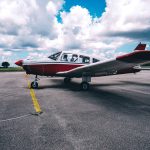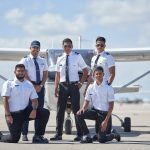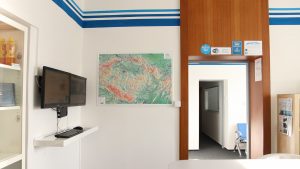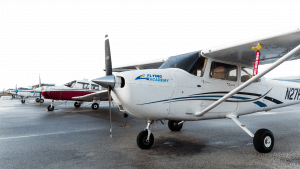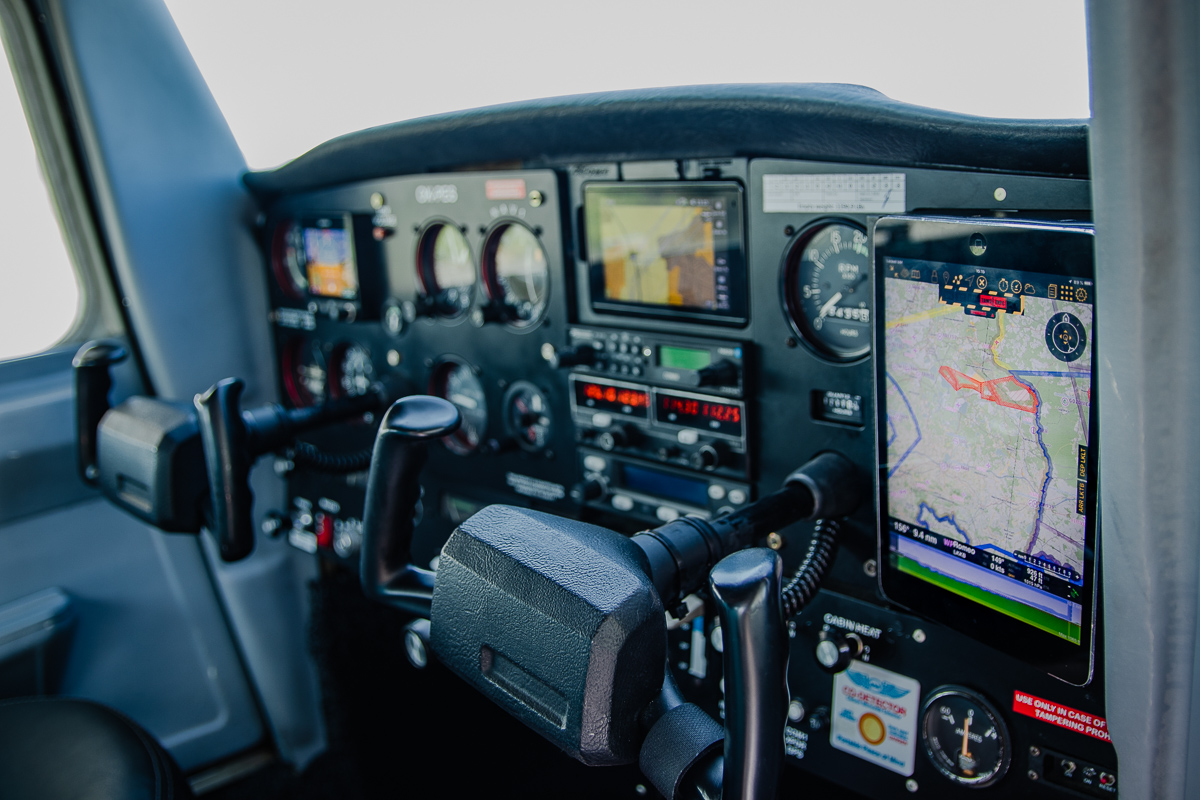
Student Pilot Semih Aydin comes to us from Turkey and has already passed several courses with Flying Academy such as his PPL(A), ATPL Theory, and Night Rating. Now, he is completing the IR SEP training program, which is the next step in his pilot career. He plans to complete his Commercial Pilot License in the future and eventually hopes to apply for a position with Turkish Airline.
We took the opportunity to join the flight crew to document his flight in Instrument Meteorological Conditions (IMC), and the weather conditions this day couldn´t be better for it. There were a temperature inversion and a visibility of 2 kilometers with clouds at 200 feet above the ground. Chief Instructor Shaun Van Der Klasthorst from South Africa was the acting Safety Pilot for Semih during this flight.
We took OK-TUR, a Cessna 172 fully equipped to fly in IMC. We contacted tower, started up the engine shortly after 0930 UTC, and asked for taxi clearance to the run-up area to do the engine and instruments check. We then lined up on the runway, took off and were instructed to contact Brno radar. We were climbing to 5,000 feet, and once we passed 250 feet above the ground, we were in IMC. Visibility dropped to zero in just a few seconds. We continued to climb, focusing on instruments and following standard instrument departure procedures. The pilots only have their instruments to rely on in such conditions. After several minutes we broke through the clouds at 2,800 feet above the ground. The difference was amazing; clear blue sky with only a few clouds at an even higher altitude than we were.
We practiced holdings over the VOR (BNO) with blue skies above us and an overcast layer below us. After completing several holdings, we requested vectors for an ILS approach on RWY 27. We started our descent and within a couple of minutes, we were back in IMC conditions with zero visibility. We listened to the ATIS to confirmed visibility and ceiling conditions for the approach which turned out to be overcast at 200 feet above ground level and visibility of 2,000 meters. We intercepted the localizer for RWY 27 and called established on the ILS still only relying on instruments due to zero visibility. During this period, disorientation can cause a pilot to feel that the flight instruments are not reading correctly. A pilot must suppress the temptation to fly based on these instincts. After several minutes, the RWY approach lights were visible and we continued down to the minimums for the low approach. At the minimums, the pilot initiated his go-around and continued his climb out.
After practicing 2 more ILS approaches, Semih decided to make a final approach to land. He descended to 2,500 feet and one last time, establishing the aircraft on the approach route. At 2,800 feet, we entered the clouds once again and continued to RWY 27 and properly landed without any mistakes. After the flight, Flight Instructor Shaun commended Semih by saying that if he was doing his Check ride, Semih would have passed with flying colors. Flying Academy would like to say thank you for the opportunity to be a flight crew member on this amazing flight! We wish nothing but success for Semih during his entire aviation career.
We took OK-TUR, a Cessna 172 fully equipped to fly in IMC. We contacted tower, started up the engine shortly after 0930 UTC, and asked for taxi clearance to the run-up area to do the engine and instruments check. We then lined up on the runway, took off and were instructed to contact Brno radar. We were climbing to 5,000 feet, and once we passed 250 feet above the ground, we were in IMC. Visibility dropped to zero in just a few seconds. We continued to climb, focusing on instruments and following standard instrument departure procedures. The pilots only have their instruments to rely on in such conditions. After several minutes we broke through the clouds at 2,800 feet above the ground. The difference was amazing; clear blue sky with only a few clouds at an even higher altitude than we were.
We practiced holdings over the VOR (BNO) with blue skies above us and an overcast layer below us. After completing several holdings, we requested vectors for an ILS approach on RWY 27. We started our descent and within a couple of minutes, we were back in IMC conditions with zero visibility. We listened to the ATIS to confirmed visibility and ceiling conditions for the approach which turned out to be overcast at 200 feet above ground level and visibility of 2,000 meters. We intercepted the localizer for RWY 27 and called established on the ILS still only relying on instruments due to zero visibility. During this period, disorientation can cause a pilot to feel that the flight instruments are not reading correctly. A pilot must suppress the temptation to fly based on these instincts. After several minutes, the RWY approach lights were visible and we continued down to the minimums for the low approach. At the minimums, the pilot initiated his go-around and continued his climb out.
After practicing 2 more ILS approaches, Semih decided to make a final approach to land. He descended to 2,500 feet and one last time, establishing the aircraft on the approach route. At 2,800 feet, we entered the clouds once again and continued to RWY 27 and properly landed without any mistakes. After the flight, Flight Instructor Shaun commended Semih by saying that if he was doing his Check ride, Semih would have passed with flying colors. Flying Academy would like to say thank you for the opportunity to be a flight crew member on this amazing flight! We wish nothing but success for Semih during his entire aviation career.

